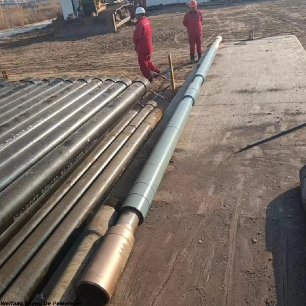The jar is one of the most vital downhole tools used in oilfield operations, designed to deliver a sudden impact that can free stuck equipment or assist in tool recovery. These tools act as the “hammers” of the drilling world, providing controlled shock loads in a highly challenging environment thousands of feet below the surface. While both drilling jars and fishing jars serve the general purpose of delivering an impact force, their designs, applications, and operational principles differ significantly. Understanding these differences is essential for selecting the right tool for the job and avoiding costly downtime or operational hazards.
Overview of a Drilling Jar
A drilling jar is a specialized tool used during drilling operations to release stuck drill strings or bottom-hole assemblies (BHAs). Its primary function is to deliver a strong upward or downward jolt to break the grip of the formation or debris holding the drill string. Drilling jars are built to operate as part of the drill string, enabling the operator to continue drilling while having the jar ready in case of sticking incidents.
Main Functions
Deliver a powerful axial shock to free stuck drilling components.
Operate within the drilling string without the need for retrieval.
Allow controlled activation by manipulating weight-on-bit and drill string tension.
Common Types
Hydraulic Drilling Jars – Utilize hydraulic resistance to create a time delay before releasing stored energy, ensuring a precise and controlled impact.
Mechanical Drilling Jars – Rely on spring-loaded mechanisms for immediate or near-instant release, offering quick reaction times.
Hydraulic-Mechanical Combination Jars – Combine both systems to provide versatility in varying downhole conditions.
Typical Application Scenarios
Freeing stuck drill collars caused by differential sticking in high-pressure zones.
Loosening drilling assemblies trapped by cuttings buildup.
Overcoming sticking due to wellbore instability or collapsed formations.
Overview of a Fishing Jar
A fishing jar is a downhole tool specifically designed for fishing operations—retrieving lost or stuck objects from the wellbore. These can include broken drill pipe segments, wireline tools, or debris that have fallen into the hole. The fishing jar delivers repeated impact forces to dislodge or break apart the stuck object so it can be recovered.
Main Functions
Deliver repeated upward impacts to break the grip of lodged debris.
Operate as part of a fishing assembly to maximize recovery efficiency.
Provide both light tapping and heavy jarring capability depending on the situation.
Types and Structural Features
Hydraulic Fishing Jars – Allow time delay control for high-impact forces.
Mechanical Fishing Jars – Provide rapid, repeated impacts, often useful in shallow or less complex fishing jobs.
Built with reinforced housing to withstand the high shock loads during retrieval.
Typical Application Scenarios
Recovering stuck wireline logging tools after cable breakage.
Retrieving broken drill pipe sections left in the hole.
Removing metallic debris or tools from the wellbore to allow operations to resume.
Key Structural Differences
Although both drilling jars and fishing jars operate on the same fundamental principle of delivering an impact to overcome downhole problems, their internal structures are specifically optimized to address different operational challenges and environments.
Impact Mechanism
Drilling Jar – Drilling jars are designed to deliver controlled and often delayed impacts. This delay is typically achieved through hydraulic systems that regulate the release of stored energy, ensuring the impact occurs at the optimal moment to avoid damaging sensitive drilling components such as drill bits, stabilizers, and measurement tools. This controlled release helps to minimize the risk of sudden shock loads that could compromise the integrity of the drill string or bottom-hole assembly.
Fishing Jar – Fishing jars, on the other hand, are optimized for repeated and immediate impacts. During fishing operations, multiple jolts are often necessary to loosen or free a stuck object. Therefore, fishing jars are built to provide rapid successive impacts without delay, allowing operators to apply a “hammering” effect that gradually breaks the bond holding the tool or debris in place.
Load Capacity and Impact Energy
Drilling Jar – These jars are constructed to withstand the high torque, tension, and axial loads encountered during drilling operations. They often feature stronger tool joints, higher tensile ratings, and robust materials designed to handle the continuous mechanical stresses of rotating and drilling in demanding downhole environments. The focus is on durability and energy absorption to maintain tool longevity while delivering powerful yet controlled impacts.
Fishing Jar – In contrast, fishing jars prioritize the ability to deliver frequent impacts rather than sustaining constant drilling loads. Their design emphasizes shock resistance and the capacity to absorb repetitive jolts without failing, as fishing tools are subject to intense and repeated shock cycles while attempting to free stuck equipment.
Tool String Compatibility
Drilling Jar – Drilling jars are integrated directly into the drill string, which typically includes components such as stabilizers, mud motors, and measurement-while-drilling (MWD) or logging-while-drilling (LWD) tools. Their design ensures smooth compatibility and operation within this complex assembly, maintaining drilling efficiency and data acquisition while providing jarring capability.
Fishing Jar – Fishing jars are used as part of specialized fishing assemblies. These assemblies may include overshots, spears, magnets, and other retrieval tools designed specifically for recovering lost or stuck objects. The fishing jar’s construction supports these tools, allowing the jar to impart the necessary impacts to free the objects without damaging the fishing tools themselves.
Operational Differences
The methods by which drilling jars and fishing jars are activated and controlled further distinguish these two types of jars, reflecting their different roles in downhole operations.
Activation Method
Drilling Jar – Drilling jars are typically activated by carefully applying a specific tension (pulling) or compression (pushing) force on the drill string. In hydraulic drilling jars, a delay period allows hydraulic fluid to pass through internal restrictions before the stored energy is suddenly released. This controlled timing is crucial for delivering the optimal impact force at the right moment to maximize effectiveness while minimizing equipment damage.
Fishing Jar – Fishing jars are generally activated more rapidly and often through a sequence of quick pulls and releases, creating a “hammering” effect. This immediate activation is essential during fishing operations because multiple rapid impacts may be required to gradually loosen and free stuck tools or debris.
Impact Direction and Control
Drilling Jar – These jars are capable of delivering impacts both upward and downward. This versatility allows drillers to choose the most effective direction based on the nature and location of the stuck point in the wellbore. The ability to switch impact direction helps address a wider range of sticking scenarios, improving the likelihood of a successful free-up.
Fishing Jar – Fishing jars are primarily designed for upward impacts, as the main objective is to lift stuck objects toward the surface for recovery. Downward impacts are rarely needed or used in fishing operations since the goal is to remove the obstruction rather than push it further into the wellbore.
Delay vs. Instant Release
Drilling Jar – The presence of a time delay before impact release is a defining feature of many drilling jars, especially hydraulic types. This delay ensures that the energy stored in the drill string is released at an ideal moment, protecting delicate tools like drill bits and sensors from sudden shocks that could cause premature wear or failure.
Fishing Jar – Instantaneous impact capability is critical for fishing jars because rapid, repeated strikes are often necessary to dislodge stuck equipment quickly. The lack of delay allows operators to react and adapt their jarring efforts in real time, improving the chances of successfully recovering lost tools.
Application Scenario Comparison
Drilling Jar in Drilling Operations
When drilling through unstable formations, a sudden collapse of the wellbore can trap the drill string. A drilling jar allows the operator to deliver a controlled shock that loosens the string without removing the assembly from the hole. This avoids expensive downtime and prevents loss of drilling progress.
Fishing Jar in Fishing Operations
In fishing situations, such as retrieving a dropped tool, the fishing jar repeatedly strikes to loosen and recover the object. This ability to deliver multiple quick impacts dramatically improves recovery success rates and reduces the need for more invasive or costly retrieval methods.
Choosing the Right Jar for the Job
Selecting the correct jar depends on the operation type, well conditions, and target tool.
Selection Criteria
Operation Type – Drilling jars for drilling, fishing jars for retrieval.
Well Conditions – High-pressure, deep wells may require hydraulic jars; shallow operations may be fine with mechanical jars.
Target Tool – Consider the weight, size, and fragility of the stuck object.
Common Mistakes and Consequences
Using a drilling jar for fishing can result in insufficient impact frequency, prolonging recovery.
Using a fishing jar during drilling risks tool failure from constant high torque loads.
Misjudging impact energy requirements can lead to equipment damage or incomplete retrieval.
Conclusion
Drilling jars and fishing jars operate on the same basic principle—delivering impact to address downhole challenges—but they differ significantly in design, operation, and purpose. Drilling jars are engineered to free stuck drill strings during drilling with precise, high-energy impacts, while fishing jars are optimized for repeated, instant impacts to retrieve lost tools or debris. Selecting the right jar is essential for maintaining operational efficiency, ensuring safety, and reducing costs. For professional guidance, quality products, and tailored solutions, Weifang Shengde Petroleum Machinery Manufacturing Co., LTD offers extensive expertise and reliable equipment to meet your specific needs. Whether you are tackling stuck pipe issues or complex fishing operations, their team can provide the right tools and technical support to help you achieve safer, faster, and more cost-effective drilling results. To learn more or discuss your requirements, you can contact Weifang Shengde directly for professional consultation and product recommendations.















